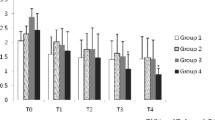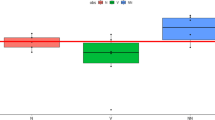Abstract
Ozone therapy acts in the body inducing controlled oxidative stress, thereby improving the antioxidant, immune and circulatory responses. However, very little is known about how this therapy affects oxidative stress indicators in dogs. We aimed to assess the clinical, hematological, biochemical and oxidative stress parameters of healthy dogs subjected to ozone therapy and oxygen therapy by rectal insufflation. Ten healthy dogs were allocated into three experimental groups in a cross-over design: control, without intervention; ozone, which received 100 µg of O3/kg through rectal insufflation; and oxygen, which received an ozone-equivalent volume of medicinal O2 through rectal insufflation. Dogs received four applications weekly and were followed up until the seventh week. Ozone therapy significantly increased the weight, mean corpuscular volume and mean platelet volume and decreased total cholesterol of treated dogs. Regarding oxidative stress, ozone therapy reduced total antioxidant capacity by ferric reduction (TAC-FRAP) in D7 compared with baseline and the control, significantly increased total antioxidant capacity by cupric reduction (TAC-CUPRAC) in D42 and D49 compared with the control group, caused an increase in uric acid compared with the oxygen group and decreased lipid peroxidation on D21 compared with the control group. In conclusion, ozone therapy through rectal insufflation causes transient oxidative stress followed by an antioxidant response and discreetly interferes with a few clinical, hematological and biochemical variables in healthy dogs, although variables still remained within the reference ranges for the species, thus proving the safety of the therapy. Furthermore, oxygen therapy causes oxidative stress without inducing a subsequent antioxidant response.








Similar content being viewed by others
Data availability
The datasets generated during and/or analyzed during the current study are available from the corresponding author on reasonable request.
References
Ajamieh H, Merino N, Candelario-Jalil E, Menéndez S, Martinez-Sanchez G, Re L, Giuliani A, Leon OS (2002) Similar protective effect of ischaemic and ozone oxidative preconditionings in liver ischaemia/reperfusion injury. Pharmacol Res 45:333–339. https://doi.org/10.1006/phrs.2002.0952
Almeida BFM, Narciso LG, Melo LM, Preve PP, Bosco AM, Lima VM, Ciarlini PC (2013) Leishmaniasis causes oxidative stress and alteration of oxidative metabolism and viability of neutrophils in dogs. Vet J 198:599–605. https://doi.org/10.1016/j.tvjl.2013.08.024
Almeida BFM, Silva KLO, Chiku VM, Leal AA, Venturin GL, Narciso LG, Fink MF, Eugênio FR, Santos PS, Ciarlini PC, Lima VM (2017) The effects of increased heme oxygenase-1 on the lymphoproliferative response in dogs with visceral leishmaniasis. Immunobiology 222:693–703. https://doi.org/10.1016/j.imbio.2016.12.006
Almeida BFM, Amatti LZ, de Souza GG, Garcia LV, Montechiesi DF, Ignácio FS, de Oliveira PL, Costa LR, Floriano BP, Bosculo MRM, Joaquim JGF, Rubio CP (2021) Effect of uterine ozone therapy and anticoagulant sampling on oxidative stress parameters in mares. Res Vet Sci 136:503–511. https://doi.org/10.1016/J.RVSC.2021.04.002
Barger AM (2003) The complete blood cell count: a powerful diagnostic tool. Vet Clin North Am Small Anim Pract 33:1207–1222. https://doi.org/10.1016/S0195-5616(03)00100-1
Benzie I, Strain J (1996) The ferric reducing ability of plasma (FRAP) as a measure of antioxidant power: the FRAP assay. Anal Biochem 239:70–76. https://doi.org/10.1006/ABIO.1996.0292
Bocci V (1996) Ozone as a bioregulator. Pharmacology and toxicology of ozonetherapy today. J Biol Regul Homeost Agents 10:31–53
Bocci VA (2006) Scientific and medical aspects of ozone therapy. State of the art. Arch Med Res 37:425–435. https://doi.org/10.1016/j.arcmed.2005.08.006
Bocci V, Borrelli E, Valacchi G, Luzzi E (1999) Quasi-total-body exposure to an oxygen-ozone mixture in a sauna cabin. Eur J Appl Physiol Occup Physiol 80:549–554. https://doi.org/10.1007/S004210050633
Bonatto NCM, de Oliveira PL, Mancebo AM, Costa LR, Bosculo MRM, Bosco AM, Ciarlini PC, Floriano BP, de Barros LD, Almeida BFM (2021) Postprandial lipemia causes oxidative stress in dogs. Res Vet Sci 136:277–286. https://doi.org/10.1016/J.RVSC.2021.03.008
Burton GJ, Jauniaux E (2011) Oxidative stress. Best Pract Res Clin Obstet Gynaecol 25:287–299. https://doi.org/10.1016/j.bpobgyn.2010.10.016
Carvalho AC, Silva JVS, Lopes JWC, Araújo ORP, Goulart MOF, Mariz TMA, Sarmento CAP, Escodro PB (2023) Effects of ozone therapy on hematological, biochemical, and oxidative stress parameters of vaquejada athlete horses. Arq Bras Med Vet Zootec 74:1024–1038. https://doi.org/10.1590/1678-4162-12733
Cunha Carvalho H, José de Lima C, Fernandes AB, Procópio Alves L, Helena Moreira L, Zângaro RA (2022) Mass transfer of ozone-blood—venturi use and influences on hematological parameters. Res Biomed Eng 38:683–688. https://doi.org/10.1007/S42600-022-00220-4/FIGURES/2
Di Filippo C, Marfella R, Capodanno P, Ferraraccio F, Coppola L, Luongo M, Mascolo L, Luongo C, Capuano A, Rossi F, D’Amico M (2008) Acute oxygen-ozone administration to rats protects the heart from ischemia reperfusion infarct. Inflam Res 57:445–449. https://doi.org/10.1007/S00011-008-7237-0
de Oliveira Martins T, Ramos RC, Possidonio G, Bosculo MRM, Oliveira PL, Costa LR, Zamboni VAG, Marques MG, de Almeida BFM (2023) Feline obesity causes hematological and biochemical changes and oxidative stress - a pilot study. Vet Res Commun 47:167–177. https://doi.org/10.1007/S11259-022-09940-5
do Prado Vendruscolo C, Moreira JJ, Raphaela Torquato Seidel S, Fülber J, Neuenschwander HM, Bonagura G, Agreste FR, Baccarin RYA (2018) Effects of medical ozone upon healthy equine joints: clinical and laboratorial aspects. PLoS ONE 13:e0197736. https://doi.org/10.1371/JOURNAL.PONE.0197736
dos Santos TG, Orlandin JR, de Almeida MF, Scassiotti RF, Oliveira VC, Santos SIP, Pereira VM, Pinto PAF, Mariano CG, Ambrósio CE (2023) Ozone therapy: protocol for treating canine parvovirus infection. Braz J Vet Med 45:e004622. https://doi.org/10.29374/2527-2179.BJVM004622
Erel O (2004) A novel automated direct measurement method for total antioxidant capacity using a new generation, more stable ABTS radical cation. Clin Biochem 37:277–285. https://doi.org/10.1016/j.clinbiochem.2003.11.015
Erel O (2005) A new automated colorimetric method for measuring total oxidant status. Clin Biochem 38:1103–1111. https://doi.org/10.1016/j.clinbiochem.2005.08.008
Haddad M, Souza M, Hincapie J, Júnior JIR, Vilória MIV (2009) Behavior of hematological variables in horses treated with ozone therapy. REDVET 10:1–12
Halliwell B, Gutteridge JMC (2015) Free radicals in biology and medicine, 5th edn. Oxford University Press, Oxford
Hernández F, Menéndez S, Wong R (1995) Decrease of blood cholesterol and stimulation of antioxidative response in cardiopathy patients treated with endovenous ozone therapy. Free Radic Biol Med 19:115–119. https://doi.org/10.1016/0891-5849(94)00201-T
Hunter MI, Nlemadim BC, Davidson DL (1985) Lipid peroxidation products and antioxidant proteins in plasma and cerebrospinal fluid from multiple sclerosis patients. Neurochem Res 10:1645–1652
Jain NC (1986) Hematologic techniques. In: Jain NC (ed) Schalm’s veterinary hematology, 4th edn. Lea & Febiger, Philadelphia, pp 20–86
Jaramillo FM, Vendruscolo CP, Fülber J, Seidel SRT, Barbosa AP, Baccarin RYA (2020) Effects of transrectal medicinal ozone in horses - clinical and laboratory aspects. Arq Bras Med Vet Zootec 72:56–64. https://doi.org/10.1590/1678-4162-11155
Joshi W, Leb L, Piotrowski J, Fortier N, Snyder LM (1983) Increased sensitivity of isolated alpha subunits of normal human hemoglobin to oxidative damage and crosslinkage with spectrin. J Lab Clin Med 102:46–52
Kaneko JJ, Harvey JW, Bruss ML (2008) Clinical biochemistry of domestic animals, 6th edn. Academic, London
Kusano C, Bucalen F (2008) Total antioxidant capacity: a biomarker in biomedical and nutritional studies. Cell Mol Biol 7:1–15
Larson RA (1987) Naturally occurring antioxidants. CRC Press LLC, New York
Moda TF, de Lima CJ, Carvalho HC, Salgado MAC, Fernandes AB, Zângaro RA, Moreira LH (2022) Effects of ozone therapy on hematological and serum biochemical parameters in dogs affected by visceral leishmaniasis. Res Soc Dev 11:e16711729886. https://doi.org/10.33448/RSD-V11I7.29886
Peake J, Suzuki K (2004) Neutrophil activation, antioxidant supplements and exercise-induced oxidative stress. Exerc Immunol Rev 10:129–141
Re L, Mawsouf MN, Menéndez S, León OS, Sánchez GM, Hernández F (2008) Ozone therapy: clinical and basic evidence of its therapeutic potential. Arch Med Res 39:17–26. https://doi.org/10.1016/J.ARCMED.2007.07.005
Rizzi TE, Meinkoth JH, Clinkenbeard KD (2010) Normal hematology of the dog. In: Weiss DJ, Wardrop KJ (eds) Schalm’s veterinary hematology, 6th edn. Wiley-Blackwell, Philadelphia, pp 799–810
Rubio CP, Hernández-Ruiz J, Martinez-Subiela S, Tvarijonaviciute A, Ceron JJ (2016a) Spectrophotometric assays for total antioxidant capacity (TAC) in dog serum: an update. BMC Vet Res 12:166. https://doi.org/10.1186/s12917-016-0792-7
Rubio CP, Tvarijonaviciute A, Martinez-Subiela S, Hernández-Ruiz J, Cerón JJ (2016b) Validation of an automated assay for the measurement of cupric reducing antioxidant capacity in serum of dogs. BMC Vet Res 12:137. https://doi.org/10.1186/s12917-016-0760-2
Sagai M, Bocci V (2011) Mechanisms of action involved in ozone therapy: is healing induced via a mild oxidative stress? Med Gas Res 1:e29. https://doi.org/10.1186/2045-9912-1-29
Schneider CD, de Oliveira AR (2004) Oxygen free radicals and exercise: mechanisms of synthesis and adaptation to the physical training. Rev Bras Med Esporte 10:308–313. https://doi.org/10.1590/S1517-86922004000400008
Soffler C (2007) Oxidative stress. Vet Clin North Am Equine Pract 23:135–157. https://doi.org/10.1016/J.CVEQ.2006.11.004
Suárez Chica A, Cardona Álvarez J, Reyes Bossa B (2022) Efecto De La aplicación intravenosa de ozono en la biometría y bioquímica hemática en caballos clínicamente sanos. Rev Med Vet (Bogota) 1:e10. https://doi.org/10.19052/mv.vol1.iss45.10
Tsuzuki N, Endo Y, Kikkawa L, Korosue K, Kaneko Y, Kitauchi A, Katamoto H, Hidaka Y, Hagio M, Torisu S (2016) Effects of ozonated autohemotherapy on the antioxidant capacity of Thoroughbred horses. J Vet Med Sci 77:1647–1650. https://doi.org/10.1292/jvms.15-0225
vand Sand C, Vieira TO, de Oliveira TB, Wilhelm Filho D, da Silva FRMB, Creczynski-Pasa TB (2007) Influence of oral glutamine and glucose on markers of oxidative stress in a paraquat rat model. E Spen Eur E J Clin Nutr Metab 2:63–67. https://doi.org/10.1016/J.ECLNM.2007.03.004
Zaky S, Fouad EA, Kotb HIM (2011) The effect of rectal ozone on the portal vein oxygenation and pharmacokinetics of propranolol in liver cirrhosis (a preliminary human study). Br J Clin Pharmacol 71:411–415. https://doi.org/10.1111/J.1365-2125.2010.03851.X
Zhang XH (2010) Regulation of protein function by residue oxidation. Proteom Insights 3:17–24. https://doi.org/10.4137/PRI.S3327
Acknowledgements
The authors would like to thank the São Paulo Research Foundation (FAPESP) for the grants provided (2020/04749-0; 2019/22681-6; 2019/22680-0).
Funding
This work was supported by São Paulo Research Foundation (FAPESP, Proc. 2020/04749-0). Authors M.OM. and G.S.G. have received a research scholarship from FAPESP (2019/22681-6 and 2019/22680-0).
Author information
Authors and Affiliations
Contributions
The study conception and design were performed by Paula Lima de Oliveira, Beatriz Perez Floriano and Breno Fernando Martins de Almeida. Animal selection, material preparation and sample collection were performed by Paula Lima de Oliveira, Mariana Mendonça Orlandini, Geovanna Santos Gonçalves, Isadora Gimenez Franco, Daniela Ribas Jané, Tainara de Oliveira Martins, Maria Rachel Melo Bosculo, Daniela Fernandez Montechiesi, Vinicius Aquiles Gomes Zamboni and Breno Fernando Martins de Almeida. Laboratory analyses were performed by Paula Lima de Oliveira, Mariana Mendonça Orlandini, Geovanna Santos Gonçalves, Tainara de Oliveira Martins, Maria Rachel Melo Bosculo and Breno Fernando Martins de Almeida. The first draft of the manuscript was written by Paula Lima de Oliveira and all authors commented on previous versions of the manuscript. All authors read and approved the final manuscript.
Corresponding author
Ethics declarations
Statement of animal ethics
The research project was approved by the Ethics Committee on Animal Use of the Centro Universitário das Faculdades Integradas de Ourinhos (CEUA-Unifio) under protocol No. 013/2019.
Ethics approval
The research project was approved by the Ethics Committee on Animal Use of the Centro Universitário das Faculdades Integradas de Ourinhos (CEUA-Unifio) under protocol No. 013/2019.
Consent to participate
The participation of each dog was authorized by its owner, who signed a free and informed consent form.
Competing interests
The authors declare no competing interests.
Additional information
Publisher’s Note
Springer Nature remains neutral with regard to jurisdictional claims in published maps and institutional affiliations.
Rights and permissions
Springer Nature or its licensor (e.g. a society or other partner) holds exclusive rights to this article under a publishing agreement with the author(s) or other rightsholder(s); author self-archiving of the accepted manuscript version of this article is solely governed by the terms of such publishing agreement and applicable law.
About this article
Cite this article
de Oliveira, P.L., Mendonça, M.O., Gonçalves, G.S. et al. Ozone therapy by rectal insufflation in dogs: safety and oxidative stress - a randomized cross-over study. Vet Res Commun (2024). https://doi.org/10.1007/s11259-024-10407-y
Received:
Accepted:
Published:
DOI: https://doi.org/10.1007/s11259-024-10407-y




